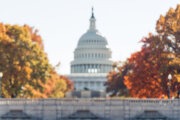Pick up a birthday card in the supermarket and you might find some humorous quips about longevity, like “Scientific research recently found that the more birthdays you have, the longer you live.”
In reality, though, that’s an experience nearly 90,000 centenarians currently living in the U.S. can relate to and appreciate, according to data from the United Nations. It’s also a phenomenon that is expected to increase over time: According to demographers from the U.S. Census Bureau, the number of centenarians is projected to grow to 130,000 by 2030 and to exceed 603,000 by 2060.
The graying of America, in general, is a megatrend. The percentage share of Americans over age 65 doubled in size from 8% in 1950 to 16.9% in 2020, according to data from Statista. Statista also estimates the number of older Americans will represent more than 20% of the U.S. population by 2030, and 22% by 2050.
Related: Sign up for stock news with our Invested newsletter.
Europe and North America are projected to experience substantial growth among older adults by 2050, with one in four individuals expected to be over the age of 65, according to the United Nations. This anticipated growth in the population share of older adults across the world could also spur a demographic dividend, which is characterized by an increase in the number of working-age individuals, accelerated growth per capita, economic expansion and enhanced social development.
Still, while the U.N. expects significant growth in the number of older adults worldwide, it also projects a slowdown in growth among the general population. By 2050, the U.N. projects there will be 1.6 billion older adults — twice the number of children under age 5 and about the same number as children under age 12.
Populations in 61 countries, including China, Bulgaria, Latvia, Lithuania, Serbia and Ukraine, are projected to experience absolute declines of 1% or more by 2050. Population growth within the U.S. is expected to remain fairly stable in the coming decades, and the U.S. should maintain its status as the third-most-populous country in the world. India is projected to supersede China in total population by mid-2023, taking top spot for most populous country, according to U.N. data released in April.
These demographic shifts have formed a longevity economy in which the anticipated economic contributions from older adults will be higher, and yet will likely benefit individuals of all ages.
The longevity economy will also likely transform how companies recruit and retain an aging workforce, how individuals plan for a lengthy retirement period, how health care treatments are delivered to individuals with long life spans and how companies connect with older consumers about services and products. It may also change public perceptions about how the terms “age” and “old” should be used.
Unretirement
When nearly 70 million workers left their jobs in 2021 — 70% of whom did so voluntarily — it was dubbed the Great Resignation. But what’s intriguing is that in less than 12 months, 68% of recent retirees said they would consider going back to work — that is, to unretire, according to CNBC’s 2022 All-America Workforce Survey. While more than half cited compensation as their primary interest in another job, a fair amount mentioned quality-of-life reasons, such as work-life balance (39%) and finding fulfillment in using their talents (30%).
Joanne Lipman, Yale University lecturer and author of “Next! The Power of Reinvention in Life and Work,” calls this phenomenon the Great Reinvention and extends its framework to include workers of all ages. “Americans are fed up with the jobs they already have,” she says. “More than two-thirds of Americans aren’t feeling engaged with their work, according to a recent Gallup poll, and job unhappiness is at a record high. Taken together, these data points suggest that the Great Reinvention is broad-based, and goes well beyond the retirement population.”
For additional context, Lipman adds, “There’s an increasing awareness that the typical career path for young people entering the workforce today will be 60 years — not the traditional 40 years-to-retirement road. That will change the way we look at careers, and also change the definition of oldness.”
Perhaps, in the backdrop, there’s also an acute self-awareness among many American workers that they may need longer runways to adequately save for retirement. The Federal Reserve’s 2019 Survey of Consumer Finances found that the median retirement savings balance per family is $65,000. Below are the savings per age group:
| Age group | Median retirement savings |
| Ages 75 and older | $83,000 |
| Ages 65-74 | $164,000 |
| Ages 55-64 | $134,000 |
| Ages 45-54 | $100,000 |
| Ages 35-44 | $60,000 |
| Less than age 35 | $13,000 |
Investment management companies, such as T. Rowe Price and Fidelity, that specialize in portfolio construction for workplace retirement-plan participants also plan for long runways for individuals after they retire. Kim DeDominicis, portfolio manager of the target-date strategies for T. Rowe Price’s multi-asset division, comments, “Over the past two decades, we’ve seen increases in life expectancy, which means the potential for individuals to have long retirements is increasing.” The Society of Actuaries estimates that one out of three males and one out of two females in their 50s now will likely live until at least age 90. “That means they’ll need their assets to last after retirement for a significant amount of time.”
Fidelity Freedom Funds and T. Rowe Price Retirement Funds are widely held target-date retirement funds within workplace retirement plans that are designed to help investors address key savings risks by holding at least 90% in equities in the formative years of an individual’s career path.
Sarah O’Toole, institutional portfolio manager at Fidelity Investments, believes innovative features within workplace retirement plans will also help employees address longevity in the future. She adds, “Many participants are worried they won’t have enough money to last a retirement horizon that may be 20 to 30 years. In addition, they are seeking help from their employers on converting accumulated savings into retirement income.”
Nationwide Retirement Institute’s “2021 In-Plan Lifetime Income” survey revealed that 88% of plan sponsors and participants believe receiving income in retirement is essential to financial security. Eight in 10 retirement plan sponsors indicated participants want guaranteed lifetime income investment options in their retirement plans.
If the unretirement trend continues, however, some retirees will also look to employers for more than just a paycheck experience. Yale University’s Lipman comments, “For some retirees, it’s simply a matter of money: They need to earn a paycheck. But for many of those I interviewed for ‘Next!‘ it was more a matter of wanting to feel useful. They’re healthy, they have accumulated all kinds of knowledge and experience through their careers, and they feel it’s time to share their wisdom.”
Some retirees also find that their hobbies or side hustles turn into a full-time job, “like 71-year-old farmer Will Brown, who spent 30 years as an economist at JPMorgan before he turned his weekend farmhouse into a cattle business,” she says.
READ: Megatrends: AI and Robotics
Economic Boomers
Americans over the age of 50 make significant contributions to the U.S. economy, both as workers and consumers. AARP’s “The Longevity Economy Outlook” estimates that older Americans (over the age of 50) contribute $8.3 trillion to the U.S. economy each year, or 40% of the U.S. gross domestic product.
“In 2030, when the first of the millennials are about to turn 50, the 50-plus age group will contribute $12.6 trillion to the U.S. economy,” AARP says. “By 2050, when Gen Zers will be turning 50, the 50-plus age group will contribute $26.8 trillion to the U.S. economy.”
Still, there is an apparent disconnect between some companies and their employees about what “age-friendly” work really means. Transamerica’s 2022 Retirement Survey found that while 84% of employers say they offer age-friendly work arrangements to their employees, only 65% of employees consider that to be a true statement about their own company.
Bayerische Motoren Werke AG (ticker: BMWYY), or BMW, is an example of how a company can effectively address the needs of an aging workforce, though. In 2007, the company’s top management team grew concerned about how its workforce could remain productive as it aged.
BMW launched a pilot program that included about 70 changes to employees’ work environments, including large-handled gripping tools, wooden flooring, barbershop chairs, orthopedic footwear, and job rotations throughout the day. By 2009, BMW achieved a 7% improvement in productivity and a 2% drop in absenteeism.
Humana Inc. (HUM) offers job opportunities specifically designed for retirees. Microsoft Corp.’s (MSFT) age-inclusive benefits provide employees with comprehensive health coverage without employee premiums, and paid weeks of annual family caregiver leave. And Marriott International Inc. (MAR) features a flex-options program, which allows older workers to transition from physically demanding jobs into other roles over time.
By 2050, AARP projects, Americans over age 50 will support nearly 102 million jobs in the U.S. and generate about $8 trillion in federal, state and local taxes in various economic activities.
Currently, Age of Majority, which specializes in consulting and marketing research related to older Americans, estimates consumers over the age of 55 spend $2.9 trillion on products and services each year — more than twice the amount spent by consumers under the age of 35 ($1.4 trillion), and nearly as much as the amount spent by 35- to 54-year-olds ($3.1 trillion). As such, nearly four out of five marketers (84%) say they want to connect more effectively with older Americans, and 79% of marketers say this group of consumers will be a growth priority in the coming years.
For investors who are curious about U.S. companies that may benefit from the buying power of an aging population, Hartford has created a relevant benchmark called the Hartford Longevity Economy Index (LHLGEX) and an exchange-traded fund, Hartford Longevity Economy ETF (HLGE), that tracks this benchmark.
Healthy Expectations
By 2030, the National Center for Biotechnology Information estimates there will be 61 million baby boomers — those born between 1946 and 1964 — living in America, plus another 9 million individuals who were born before 1946. And while an estimated 60% of American adults have at least one chronic disease (e.g., diabetes or heart disease), according to data from the National Association of Chronic Disease Directors, the future of health care for older Americans will likely center on data-driven care supported by artificial intelligence and even prevention.
“Health care treatments have increasingly improved to keep people alive and survive conditions and events that would have previously had much higher rates of mortality,” says Tom Buford, professor of gerontology at the University of Alabama, Birmingham’s Department of Medicine. “However, with that increased longevity comes a significant increase in the number of older people with chronic conditions that impact quality of life and the ability to fully engage in one’s chosen activities that support happiness.” He adds, “Accordingly, we still have some work to do to improve ‘health span’ to go alongside improvements in life span.”
The Deloitte Center for Health Solutions projects that by 2040, “the consumer will be at the center of the health model.” More data will promote closer collaboration among industry stakeholders, and new combinations of services will be offered by both incumbents and disruptors.
“Interventions and treatments are likely to be more precise, less complex, less invasive and cheaper,” the Deloitte Center says. For example, Deloitte anticipates that consumers will replace hospitals as the “center of gravity” for health care delivery. “Organizations that want to play a role in the delivery of care should determine how they can expand their points of access to get closer — both physically and digitally — to their customers.”
Health plans will develop business models beyond claims processing and focus more on the well-being of their members, Deloitte predicts. Health plans will become “data conveners, science and insight engines, and/or data and platform infrastructure builders,” Deloitte says.
“Many treatment initiatives on the horizon are now looking at biological aging as a key target of therapeutic treatments rather than simply focusing on the disease itself,” Buford adds. “A number of large startups and research foundations have been launched in this space.”
To invest in this megatrend, a promising vehicle is Vanguard Health Care ETF (VHT), which is passively managed, tracks a broad sample of health care organizations within the U.S., including companies that specialize in health care equipment, biotechnology and pharmaceuticals.
The Gray Wave’s Silver Lining
Within the U.S. and abroad, many economies will likely see a significant increase in the 50-plus share of consumer spending in the coming three decades. By 2050, individuals older than 50 will account for 60% of consumer spending in 60 of the core 76 economies across the globe. Also, by 2050, the 50-plus population will account for nearly one-third of the world’s population, according to data from AARP.
These demographic shifts will beckon business leaders and policymakers to adapt for multiple generations of individuals who will likely need — and require — innovative employment options, consumer services and products, and health care for many years to come.
More from U.S. News
7 Best Stocks to Buy for Rising Interest Rates
7 of the Best Growth Funds to Buy and Hold
7 Money Market Funds to Buy for Safety
Megatrends: The Longevity Economy originally appeared on usnews.com







